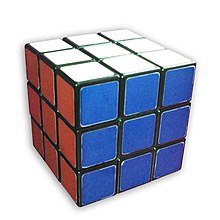Rubik's Cube
 | |
| Other names | Magic Cube, Speed Cube, Puzzle Cube, Cube |
|---|---|
| Type | Combination puzzle |
| Inventor(s) | Ernő Rubik |
| Company | Rubik's Brand Ltd (Spin Master)[1] |
| Country | Hungary |
| Availability | 1977: as Hungarian Magic Cube, first test batches released in Budapest As Rubik's Cube, worldwide, 1980–present |
| Official website | |
The Rubik's Cube is a puzzle cube, and the world's biggest selling toy of all time with over 300,000,000 (300 million) sold. It was invented in 1974 by Hungarian sculptor and professor of architecture Ernő Rubik. In a classic Rubik's Cube, each of the six faces is covered by nine stickers, each of one of six solid colours: white, red, blue, orange, green, and yellow. In currently sold models, white is opposite yellow, blue is opposite green, orange is opposite red, and some might replace blue with black or purple. The goal of the puzzle is to make all 6 faces have the same color.
Types of Cubes[change | change source]
The standard Rubik's Cube is 3x3x3. 3 blocks across, 3 blocks down, and 3 blocks deep. Cubes can be made in 2x2, 4x4, or larger versions. As of 2017[update] the largest cube is 33 x 33, which is also 3d printed.[2]
Cuboids are cubes with uneven sides. Some options are the 3x2x2 or 3x5 or 4x3. Some cuboids can shapeshift or jumble. That means the cube goes out of its original shape. To solve a shapeshifting cube it must return to the original shape before it is considered solved.
Gear cubes include gears which cause both sides of a cube to turn.
Other versions include the Megaminx, Pyraminx, Rubik's clock, Mirror Cube, and Square 1.

Structure[change | change source]

A Rubik's Cube is a cube split into a number of smaller cubes with different colored faces attached to a rotating piece of metal in the middle. Total, there are 26 small cubes. The Rubik's Cube have six sides with 9 little cubes attached to it per side and each side has one color. Red, yellow, blue, orange, white and green are the most common colors.
The cubes can be rotated and twisted along rows and faces. The aim of the puzzle is to make each face of the cube have the same color. Solving a Rubik's Cube requires logic and thinking. There are many different ways to learn how to solve a Rubik's cube.
Methods[change | change source]
There are many methods that people use to solve a Rubik's Cube. The most simple and easiest one is called the Beginner Method. In this method first the white cross is solved. Then the white layer is solved, followed by the middle layer. Finally, the yellow cross is solved, then the yellow corners.[3] Today the most common method is called CFOP, also called the Fridrich Method, named after the popularizer Jessica Fridrich. It starts with the white cross, then F2L (First 2 Layers) followed by OLL (Orientation of the Last Layer) and PLL (Permutation of the Last Layer). Other methods include Petrus, ZZ, Roux, and others.
Records[change | change source]
The record for one Rubik's Cube solve is 3.13 by Max Park. The record for an average of 5 solves is 4.48 By Yiheng Wang.[4]
According to Guinness World Records, the fastest time a robot has solved a Rubik's Cube is 0.637 seconds. This was done by the robot "Sub1 Reloaded", created by Albert Beer.[5] However, a faster time of 0.38 seconds was claimed by a robot built at the Massachusetts Institute of Technology.[6]
The shortest solutions[change | change source]
Every single rubik's cube configuration can be solved in 20 moves or less if half turns count as 1 move. If half turns count as 2 moves the number would be 26.
Related pages[change | change source]
References[change | change source]
- ↑ Evans, Pete (27 October 2020). "Canadian company that owns classic toys Etch A Sketch and Aerobie buys Rubik's Cube for $50M". CBC News.
- ↑ "33x33x33 rubik's cube - World Record". Ruwix. 2 December 2017. Retrieved 14 September 2019.
- ↑ RBL_solve_guide_CUBE_US_5.375x8.375in_AW_27Feb2020_VISUAL.pdf (rubiks.com)
- ↑ "Records | World Cube Association". www.worldcubeassociation.org. Retrieved 2023-06-27.
- ↑ "Fastest robot to solve a puzzle cube". Guinness World Records. Retrieved 2022-04-02.
- ↑ Specktor, Brandon (2018-03-16). "Watch a Robot Solve a Rubik's Cube in 0.38 Seconds". livescience.com. Retrieved 2022-04-06.
